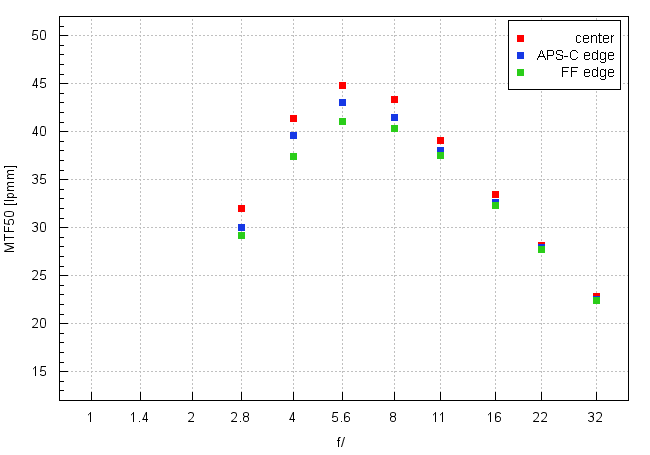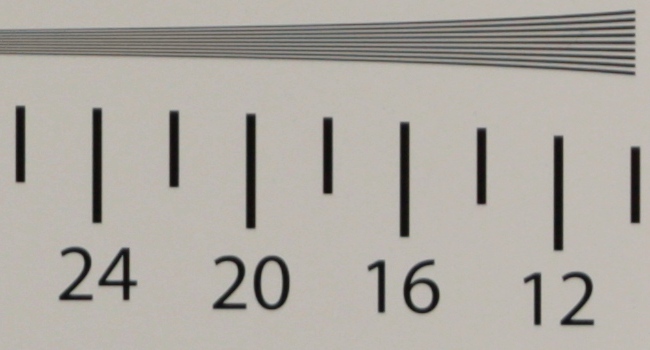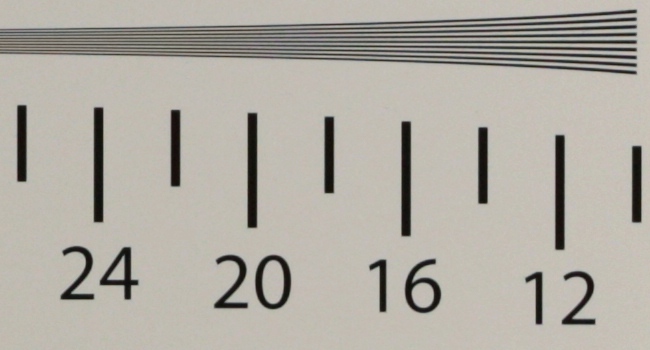Irix 150 mm f/2.8 MACRO 1:1 Dragonfly
4. Image resolution
Let’s check how the Irix 150ámm f/2.8 MACRO 1:1 Dragonfly compares; its results in the frame centre and on the edge of both, the APS-C/DX and full frame, presents a graph below.

Please Support UsIf you enjoy our reviews and articles, and you want us to continue our work please, support our website by donating through PayPal. The funds are going to be used for paying our editorial team, renting servers, and equipping our testing studio; only that way we will be able to continue providing you interesting content for free. |
- - - - - - - - - - - - - - - - - - - - - - - - - - - - - - - - - - - - - - - - - - - - - - - -
In the frame centre, with a result of 34 lpmm, images are fully useful already from the maximum relative aperture. On stopping down to f/4.0 the lens is able to exceed a very high level of 40 lpmm and the peak of its possibilities is reached by f/5.6 with resolution amounting to almost 45 lpmm.
How these results compare to those of the rivals? Perhaps the most important thing is that the Irix doesn't have to be ashamed when stacked up against the more expensive Sigma 150 mm f/2.8 APO EX DG OS HSM Macro. It loses only slightly by f/2.8 but the difference amounts to just a level of measuring error. By f/4.0 and f/5.6 the Irix proves to be actually sharper than the Sigma – an excellent recommendation in itself.
Any flies in the ointment? Yes, a small one. The Sigma 150 mm f/2.8 APO EX DG OS HSM Macro can be already called an old construction. If you compare the performance of the Irix to other contemporary full frame macro models the results of the tested lens don't seem so impressive any more. For example the Sigma 180 mm f/2.8 APO Macro EX DG OS HSM was able to go higher than 40 lpmm already by f/2.8 and by f/4.0 it reached almost 45 lpmm. The Sigma A 70 mm f/2.8 DG Macro, tested by us not so long ago, by f/2.8 was able to exceed 46 lpmm and by f/4.0 had a result over 48 lpmm. Still, in order to keep the right proportions, you have to add that both Sigmas, the 150 and the180 mm, are much more expensive than the Irix; the Sigma 70 mm f/2.8 Macro, similarly priced, comes with a much shorter focal length and it changes dimensions while focusing. If you, however, want to move among full frame macro lenses of the same price point as the tested Irix the situation changes. You might, for example, compare the Irix to the Samyang 100 mm f/2.8 ED UMC MACRO, and it's a lens that doesn't fare better than the one we are testing right now.
Profiting from the fact that we had as many as five testing charts of different sizes in our editorial office, we performed our resolution test on all of them and for two reasons. Firstly, as we mentioned in the previous chapter, setting focus for distances greater than one meter is problematic, meaning a photographer has to bend over backwards to find the right position. Downsizing the focusing charts we approached the photographed object and moved towards areas where the focusing ring allowed us more and more precise settings. Secondly, we wanted to check whether the lens is able to improve its performance as it passes to the macro scale. Our results proved to be in perfect accordance, within the margin of error – the lens performed exactly the same on all testing charts, used by us. Let's progress now to the performance on the edge of the frame. The graph shows clearly that the results on the edge of APS-C/DX and full frame lag behind the frame centre just slightly. It means the lens is characterized by even distribution of resolution values across the frame, one of sought-after features in a good macro lens.
If you wanted to pick holes you might indicate the performance by f/2.8, with results on the border of the decency level. Still on stopping down to f/3.2–3.5 images become sharper across the frame. When you compare that performance to that of the rivals, you don't have any problems with finding a better one (e.g. concerning much more expensive Sigmas 150 and 180 mm) but there are also lenses weaker than the tested Irix, like the Samyang 100 mm f/2.8 ED UMC Macro, which had to be closed down to near f/5.0 in order to get sharp images on the edge of full frame.
At the end of this part of our test, traditionally we present crops taken from photos of our resolution testing chart saved as JPEG files.
| Canon 5DáMkIII, JPEG, 150ámm, f/2.8 |
 |
| Canon 5DáMkIII, JPEG, 150ámm, f/5.6 |
 |






